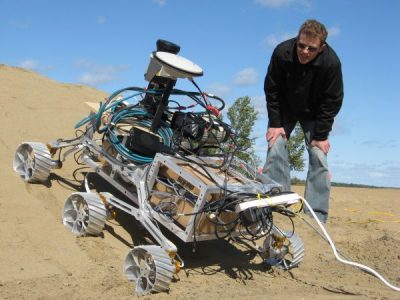Out of this world research
The space division of the Department of Mechanical and Aerospace engineering has been active within the international space landscape since the launch of the Shuttle Remote Manipulator System (SRMS) also known as the Canada Arm 1. In the early 1980s, the department collaborated with the National Research Council and MDA Robotics and Automation (formerly Spar Aerospace) on the NASA-led program.

Photo: Developed from the design concept of Dr. Alex Ellery, Carleton University was the lead technical authority for the Canadian Space Agency’s Kapvik rover project.
Since then, Carleton has recruited faculty members with extensive strengths in space robotics and related technologies, contributing directly or indirectly to several Canadian space initiatives such as the Polar Communication Weather Satellite (PCW), and Sci-sat 1. A member of the department also holds a Canada Research Chair in Space Robotics and Space Technologies.
Carleton’s research achievements include the development and testing of leading-edge space-robotic technologies in three areas: orbital robotics, planetary robotics, and spacecraft system technologies. One of the goals is to increase the technology readiness levels (TLR) of the current technologies, ultimately leading to on-orbit validations.
With funding from the Canada Foundation for Innovation, the Natural Sciences and Engineering Research Council of Canada, and the Canadian Space Agency, and in collaboration with MDA Robotics and Automation and Neptec Design Group Ltd, autonomous orbital robotic technologies for small, low-cost, free-flyer spacecraft are being developed and experimentally validated. These innovations include autonomous path-planning, advanced control systems, dexterous robotic manipulators, and machine vision and sensor fusion.
Validation of orbital robotic technologies has been accomplished in two ways: aboard the International Space Station through the NASA-MIT SPHERES facility; and in laboratory studies at Carleton using space-qualified flight hardware. One example of the latter is the recently commissioned Spacecraft Robotics and Control Laboratory where a 20,000 pound, 8 feet by 12 feet solid black granite slab is used to emulate the dynamics of space.
In association with eight industrial and academic partners, including Carleton’s Department of Earth Sciences, and with further funding from NSERC and CSA, unique technologies for autonomous planetary rovers are being developed. Researchers use Carleton’s own Mars Yard Facility to replicate planetary terrains for technologies such as CSA’s Kapvik rover, a micro-rover terrestrial proto-type of a lunar scientific rover developed in partnership with Carleton.
Widely recognized for its work in the area of spacecraft thermal control systems, space researchers have developed an innovative heat pipe, along with loop heat pipe technologies that have been successfully applied to lunar rovers. This research is integral to the successful missions of planetary rovers due to the often freezing temperatures on other planets.





